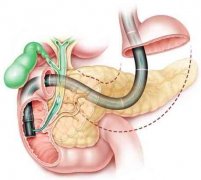 通过测定ERCP术后4小时以及6小时血清淀粉酶和脂肪酶水平预测ERCP术后胰腺炎的前瞻性研究
通过测定ERCP术后4小时以及6小时血清淀粉酶和脂肪酶水平预测ERCP术后胰腺炎的前瞻性研究
引言:急性胰腺炎是ercp术后最常见和最严重的不良事件。目的:评估ercp术后四小时和六小时血清淀粉酶和脂肪酶水平对预测ercp术后胰腺炎的有效性,并且设定最佳的诊断界值。背景:早期对ercp术后胰腺炎的的诊断,可以使患者在接受ercp治疗之后更快、更安全的即日出院,亦可使ercp术后胰腺炎的患者得到更及时合理的治疗。方法:我们前瞻性地选取自2015年10月至2016年6月间,在医院接受过ercp治疗的患者。并测定他们术后4小时和6小时,以及次日凌晨的血清淀粉酶和脂肪酶。我们选择了灵敏度及特异度最佳的诊断界值。
结果:在480例接受ercp治疗的患者中,有19例(发病率3.9%)出现了术后胰腺炎。ercp术后4小时血清淀粉酶和脂肪酶的受试者工作曲线显示曲线下面积分别为0.884和0.877,作为ercp术后胰腺炎的预测因子,显示其具有良好的测试性能(p1,p2均<0.001)。ercp术后6小时血清淀粉酶和脂肪酶的受试者工作曲线曲线下面积分别为0.928和0.895。通过比较两者的受试者工作曲线可以发现,前者(4h)相较于后者(6h),预测性能更具明显优势(p4h=0.0258,p6h=0.0255)。女性患者、治疗过程、乳头预切开以及总过程时间过长已被证实为ercp术后胰腺炎的危险因素。ercp术后4小时血清淀粉酶和脂肪酶对预测ercp术后胰腺炎的诊断界值分别为2倍参考上限值和4倍参考上限值。ercp术后6小时血清淀粉酶和脂肪酶对预测ercp术后胰腺炎诊断界值分别为2.5倍参考上限值和6倍参考上限。
结论:尽管ercp术后4小时和6小时血清淀粉酶和脂肪酶的水平均为预测ercp术后胰腺炎的有效指标,但6h的预测水平可能更具优势。
Prospective study of prediction of post-ERCP pancreatitis by 4-hour and 6-hour post-ERCP serum amylase and lipase level
Introduction: Acute pancreatitis is the most common and serious adverse event of endoscopic retrograde cholangiopancreatography (ERCP).Aim: To evaluate the usefulness of 4-hour and 6-hour post-ERCP serum amylase and lipase levels for predicting PEP and set optimal cut-off values of them. Background: Early prediction of post-ERCP pancreatitis (PEP) could enable earlier safe same-day discharge of outpatients after ERCP and earlier proper management of PEP in all the patients. Method: We prospectively select patients who receive ERCP with hospital care between October 2015 and June 2016. Their serum amylase and lipase levels are measured 4-hours and 6-hours after ERCP as well as the next morning. We select optimal cut-off values with balanced upper-most sensitivity and specificity.
Results: PEP occurred in 19 (3.9%) patients after 480 ERCP procedures. The receiver-operator characteristic curve for 4-hour post-ERCP serum amylase and lipase showed that areas under the curve were 0.884 and 0.877, demonstrating good test performances as a predictor of PEP (both P<0.001). ROC curve for 6-hour post-ERCP serum amylase and lipase showed that AUC were 0.928 and 0.895. In pairwise comparisons of the ROC curves of 4-hours and 6-hours post ERCP amylase and lipase, the 4-hours amylase and lipase found to have significantly higher predictive power than 6-hours of them (p¼0.0258, p¼0.0255, rspectively). Female sex, therapeutic procedure, prior EST and longer total procedure time were identified as the risk factors for PEP. The optimal cut-off value of 4-hour post-ERCP serum amylase and lipase level for prediction of PEP were the 2 times the upper lime of reference (ULR) and 4 times the ULR, respectively. In case of 6-hour post-ERCP, the optimal cut-off values were the 2.5 times the ULR of serum amylase level and the 6 times the ULR of serum lipase level.
Conclusion: Although both the 4-hour and 6-hour post-ERCP serum amylase and lipase levels would be useful measures for predicting PEP, their 6-hour levels seem to be superior to their 4-hour levels.
翻译:胡越 审校:张立超 侯森林 (Pancreatology 2017)


